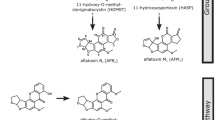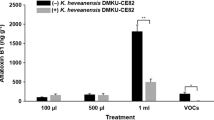Abstract
Aflatoxin contamination levels vary from crop to crop, suggesting that it is of great significance to explore the effects of different substrates on aflatoxins production. In this study, the effects of corn, wheat, peanut, and soybean on aflatoxin B1 (AFB1) production by Aspergillus parasiticus were investigated, and the effects of corn germ, wheat germ, soybean, and peanut oils on the production of AFB1 by A. parasiticus in the corresponding defatted substrates were evaluated at the rates of 2, 5, 10, and 15 g/100 g of substrate. The effects of the combinations of different oils with different defatted substrates on the accumulation of AFB1 by A. parasiticus were also studied. AFB1 concentration was determined by HPLC. The results indicated that high-lipid substrates of soybean and peanut had significantly higher AFB1 production than low-fat substrates of wheat and corn throughout the entire incubation period (15 days) in both autoclaved and non-autoclaved grains. Corn germ, wheat germ, soybean, and peanut oils with different doses could effectively stimulate AFB1 accumulation, and AFB1 production was determined by the oil content of the substrates. Our results suggest that the oil content of substrates is one of the factors affecting AFB1 production by A. parasiticus and that the composition and content of the substrates may also play a role.



Similar content being viewed by others
References
Dhingra OD, Jham GN, Rodrigues FA, Silva GJ, Costa MLN (2009) Fumigation with essential oil of mustard retards fungal growth and accumulation of ergosterol and free fatty acid in stored shelled groundnuts. J Stored Prod Res 45:24–31
Mukanga M, Derera J, Tongoona P, Laing MD (2010) A survey of pre-harvest ear rot diseases of corn and associated mycotoxins in south and central Zambia. Int J Food Microbiol 141:213–221
Kamika I, Takoy LL (2011) Natural occurrence of aflatoxin B1 in peanut collected from Kinshasa, Democratic Republic of Congo. Food Control 22:1760–1764
Perrone G, Haidukowski M, Stea G, Epifani F, Bandyopadhyay R, Leslie JF, Logrieco A (2014) Population structure and Aflatoxin production by Aspergillus Sect. Flavi from corn in Nigeria and Ghana. Food Microbiol 41:52–59
Astoreca AL, Dalcero AM, Pinto VF, Vaamonde G (2011) A survey on distribution and toxigenicity of Aspergillus section Flavi in poultry feeds. Int J Food Microbiol 146:38–43
Riba A, Bouras N, Mokrane S, Mathieu F, Lebrihi A, Sabaou N (2010) Aspergillus section Flavi and aflatoxins in Algerian wheat and derived products. Food Chem Toxicol 48:2772–2777
Mutegi CK, Ngugi HK, Hendriks SL, Jones RB (2009) Prevalence and factors associated with aflatoxin contamination of peanuts from Western Kenya. Int J Food Microbiol 130:27–34
Ma XY, Wang WF, Chen XJ, Xia Y, Wu SJ, Duan N, Zhou P (2014) Selection, identification, and application of aflatoxin B1 aptamer. Eur Food Res Technol 238:919–925
Komala VV, Ratnavathi CV, Kumar BSV, Das IK (2012) Inhibition of aflatoxin B1 production by an antifungal component, eugenol in stored sorghum grains. Food Control 26:139–146
Razzaghi-Abyaneh M, Shams-Ghahfarokhi M, Yoshinari T, Rezaee MB, Jaimand K, Nagasawa H, Sakuda S (2008) Inhibitory effects of Satureja hortensis L. essential oil on growth and aflatoxin production by Aspergillus parasiticus. Int J Food Microbiol 123:228–233
Leszczynska J, Kucharska U, Zegota H (2000) Aflatoxins in nuts assayed by immunological methods. Eur Food Res Technol 210:213–215
International Agency for Research on Cancer (1993) Aflatoxins. Some naturally occurring substances: food items and constituents, heterocyclic aromatic amines and mycotoxins. IARC Monographs on the evaluation of carcinogenic risks to humans, vol. 56. IARC, Lyon
Kumar A, Shukla R, Singh P, Dubey NK (2010) Chemical composition, antifungal and antiaflatoxigenic activities of Ocimum sanctum L. essential oil and its safety assessment as plant based antimicrobial. Food Chem Toxicol 48:539–543
Kedia A, Prakash B, Mishra PK, Dubey NK (2014) Antifungal and antiaflatoxigenic properties of Cuminum cyminum (L.) seed essential oil and its efficacy as a preservative in stored commodities. Int J Food Microbiol 168:1–7
Zanon MSA, Chiotta ML, Giaj-Merlera G, Barros G, Chulze S (2013) Evaluation of potential biocontrol agent for aflatoxin in Argentinean peanuts. Int J Food Microbiol 162:220–225
Diao EJ, Hou HX, Chen B, Shan CP, Dong HZ (2013) Ozonolysis efficiency and safety evaluation of aflatoxin B1 in peanuts. Food Chem Toxicol 55:519–525
Prakash B, Singh P, Mishra PK, Dubey NK (2012) Safety assessment of Zanthoxylum alatum Roxb. essential oil, its antifungal, antiaflatoxin, antioxidant activity and efficacy as antimicrobial in preservation of Piper nigrum L. fruits. Int J Food Microbiol 153:183–191
Keller NP, Butchko RAE, Sarr B, Phillips TD (1994) A visual pattern of mycotoxin production in maize kernels by Aspergillus spp. Phytopathology 84:483–488
Smart MG, Wicklow DT, Caldwell RW (1990) Pathogenesis in Aspergillus ear rot of maize: light microscopy of fungal spread from wounds. Phytopathology 80:1287–1294
Mellon JE, Cotty PJ, Dowd MK (2000) Influence of lipids with and without other cottonseed reserve materials on aflatoxin B1 production by Aspergillus flavus. J Agric Food Chem 48:3611–3615
Davis ND, Diener UL, Agnihotri VP (1967) Production of aflatoxins B1 and G in chemically defined medium. Mycopathol Mycol Appl 31:251–254
Reddy TV, Viswanathan L, Venkitasubramanian RA (1972) Factors affecting aflatoxin production on a synthetic medium. Biochem J 128:61
Yan SJ, Liang YT, Zhang JD, Liu CM (2012) Aspergillus flavus grown in peptone as the carbon source exhibits spore density- and peptone concentration-dependent aflatoxin biosynthesis. BMC Microbiol 12:1–14
International Organization for Standardization (ISO) 6496 (1999) Animal feeding stuffs—determination of moisture and other volatile mater content
Kartika IA, Yuliani S, Kailaku SI, Rigal L (2012) Moisture sorption behaviour of jatropha seed (Jatropha curcas) as a source of vegetable oil for biodiesel production. Biomass Bioenergy 36:226–233
Gibriel YAY, Hamza AS, Gibriel AY, Mohsen SM (2012) In vivo effect of mint (Mentha viridis) essential oil on growth and aflatoxin production by Aspergillus flavus isolated from stored corn. J Food Saf 31:445–451
AOAC Method 990.33 (2000) Aflatoxins in corn and peanut butter. AOAC International
China feed database. Tables of feed composition and nutritive values in China (2013, 24 edition). http://www.chinafeeddata.org.cn
Zhang XY, Zhu SJ, Han SY, Xu J, Liu H, Tang FS, Dong WZ, Zang XW, Zhang ZX (2011) Inheritance of fat and fatty acid compositions in peanut (Arachis hypogaea L.). J Agric Sci Technol 12:943–946
Chang PK, Wilson RA, Keller NP, Cleveland TE (2004) Deletion of the Delta 12-oleic acid desaturase gene of a nonaflatoxigenic Aspergillus parasiticus field isolate affects conidiation and sclerotial development. J App Microbiol 97:1178–1184
Wilson RA, Calvo AM, Chang PK, Keller NP (2004) Characterization of the Aspergillus parasiticus Delta 12-desaturase gene: a role for lipid metabolism in the Aspergillus–seed interaction. Microbiology 150:2881–2888
Lillehoj EB, Garcia WJ, Lambrow M (1974) Aspergillus flavus infection and aflatoxin production in corn: influence of trace elements. Appl Microbiol 28:763–767
Ehrlich K, Ciegler A (1985) Effect of phytate on aflatoxin formation by Aspergiilus parasiticus grown on different grains. Mycopathologia 92:3–6
Gupta SK, Venkitasubramanian TA (1975) Production of aflatoxin on soybeans. Appl Environ Microbiol 29:834–836
Doyle MP, Marth EH (1978) Aflatoxin is degraded at different temperatures and pH values by mycella of Aspergillus parasiticus. Eur J Appl Microbiol Biotechnol 6:95–100
Shill CN, Marth EH (1975) Aflatoxin can be degraded by the mycelium of Aspergillus parasiticus. Z Lebensm Unters Forsch 158:361–362
Passone MA, Girardi NS, Ferrand CA, Etcheverry M (2012) In vitro evaluation of five essential oils as botanical fungitoxicants for the protection of stored peanuts from Aspergillus flavus and A. parasiticus contamination. Int Biodeterior Biodegrad 70:82–88
Dall’Asta C, Falavigna C, Galaverna G, Battilani P (2012) Role of maize hybrids and their chemical composition in Fusarium infection and fumonisin production. J Agric Food Chem 60:3800–3808
Bewley JD, Black M (1985) Seeds: Physiology of development and Germination, Plenum, New York, p 16
Evans JL, Moclock MA, Gealt MA (1986) The fatty acid composition of the conidia and mycelia of the fungus Aspergillus nidulans. Can J Microbio 132:179–181
Calvo AM, Gardner HW, Keller NP (2001) Genetic connection between fatty acid metabolism and sporulation in Aspergillus nidulans. J Biol Chem 276:25766–25774
Calvo AM, Hinze LL, Gardner HW, Keller NP (1999) Sporogenic effect of polyunsaturated fatty acids on development of Aspergillus spp. Appl Environ Microbiol 65:3668–3673
Blessin CW, Inglett GE, Garcia WJ, Deatherage WL (1972) Defatted germ flour-food ingredient from corn. Food Prod Dev 6:34–35
Garcia WJ, Blessin CW, Inglett GE (1972) Mineral constituents in corn and wheat germ by atomic absorption spectroscopy. Cereal Chem 49:158–167
Garcia WJ, Gardner HW, Cavins JF, Stringfellow AC, Blessin CW, Inglett GE (1972) Composition of air-classified defatted corn and wheat Aspergillus spp. Appl Environ Microbiol 65:3668–3673
Acknowledgments
This work was supported by the National Natural Science Foundation of China (NSFC) (31272479, 31072058). We are grateful to Prof. Chun-Ming Liu (Institute of Botany, Chinese Academy of Sciences, China) for providing the A. parasiticus NRRL2999 strain.
Conflict of interest
None.
Compliance with Ethics Requirements
This article does not contain any studies with human or animal subjects.
Author information
Authors and Affiliations
Corresponding author
Rights and permissions
About this article
Cite this article
Ma, H., Zhang, N., Sun, L. et al. Effects of different substrates and oils on aflatoxin B1 production by Aspergillus parasiticus . Eur Food Res Technol 240, 627–634 (2015). https://doi.org/10.1007/s00217-014-2364-z
Received:
Revised:
Accepted:
Published:
Issue Date:
DOI: https://doi.org/10.1007/s00217-014-2364-z




